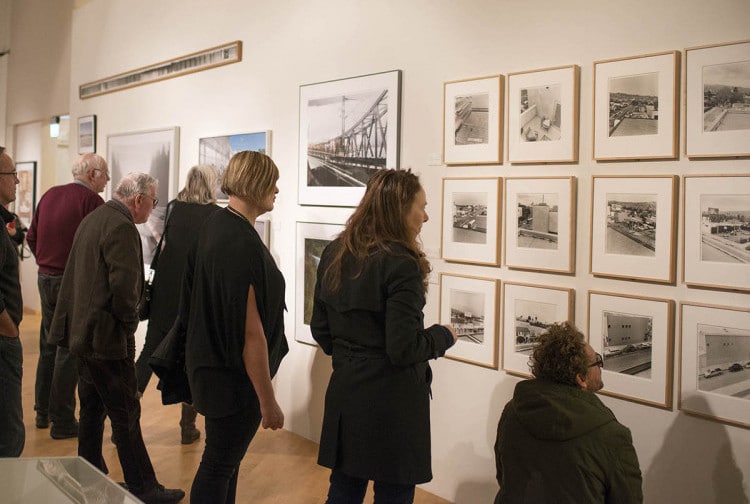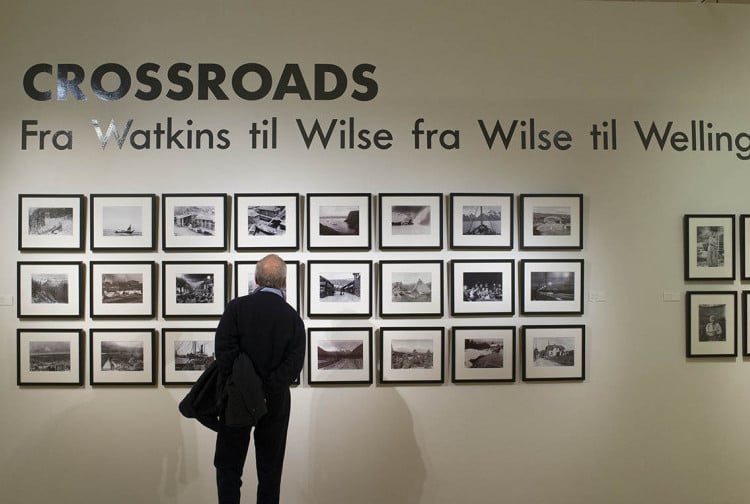Crossroads
This year it is 150 years since the Norwegian photographer Anders Beer Wilse was born and this exhibition marks the start of the Wilse anniversary 2015
Wilse (1865 - 1949) went to America as an engineer in 1884 and returned to Norway as a photographer in 1901.
Wilse's photographs are used as guides into the landscape by Norwegian and American photographers in the exhibition. At the same time as Wilse, Edward Curtis, famous for his Native American photographs, was active in Seattle. Contrasts and similarities between the two photographers point to the crossroads between a more documentary and an aesthetic photograph that characterizes American photography at the beginning of the 20th century. Wilse tries to ride both horses, where Curtis makes a choice in the direction of a photographic art language. Curtis photographs are richly represented in the exhibition.
From Wilse, the road continues until today, where American and Norwegian photographers are presented side by side. The motifs we find largely address the longing to return to a wild and romantic landscape that has had such great significance for both Norwegian and American art.
Artists represented in the exhibition:
- Alf Arhur Rothstein
- Alfred Stieglitz
- Carleton E. Watkins
- Cooper, Thomas Joshua
- Dag Alveng
- Dan Young
- Diane Arbus
- Ed Ruscha
- Edward S. Curtis
- Edward Weston
- Eline Mugaas
- Frederick I. Monsen
- Geir Egil Bergjord
- Geir M. Brungot
- James Welling
- Jamie Parslow
- Jens Hauge
- Jim Bengston
- Johan Sandborg
- Lee Friedlander
- Lewis Baltz
- Matta-Clark, Gordon
- Mette Tronvoll
- Patrick Huse
- Per Berntsen
- Robert Adams
- Robert Robinson
- Rune Johansen
- Siggen Stinessen
- Tom Martinsen
- Tom Sandberg
- Walker Evans
- William Eggleston
- Wilse, Anders Beer
Character tips
CROSSROADS - from Watkins to Wilse from Wilse to Welling
American and Norwegian art photography are in a close relationship with each other. The exhibition Crossroads examines this relationship by showing a number of Norwegian, American and American-Norwegian photographers' work. The exhibition is based on the Norwegian photographer Anders Beer Wilse's production in Seattle before he started photographing in Norway. For Wilse, his long stay in Seattle was a crossroads. In the exhibition, Wilse's photographs serve as guides into the Norwegian and American landscape.
Anders Beer Wilse (1865 - 1949) is perhaps Norway's most famous photographer. Before he started as a photographer in Norway in 1900, he had had an extensive business in Seattle. His production in the USA and later in Norway, is the starting point for the exhibition. It deals with how Wilse places itself at an intersection between American and Norwegian photography. This intersection is characterized by a pragmatic approach to photography - through documentation of nature and culture - but also as a source of aesthetic experiences.
Photographs by well-known Norwegian and American artists tell of a strikingly similar approach to Norwegian and American culture and art, to city and country and to the center and periphery. They show an almost religious relationship with nature as a place of mental and physical purification. At the same time, the landscape becomes a place for aesthetic experiences. In tourism, the same nature is utilized as a basis for new industries.
The selection of photographers is based on how Wilse worked when he was a photographer in Seattle. He portrayed a society at the intersection of evolving away from an economy based on primary industries, towards a modern industrial society. At the same time, the indigenous people were displaced by the Indians. In Wilse's photographs from the USA in the 1890s, these societal changes are documented in a way that shows that Wilse stands in an American tradition from the great nature photographer Carleton Watkins to a postmodernist like James Welling. It is a tradition that is as much concerned with aesthetic imagery as pure documentation.
Wilse's photographic art points further towards postmodernism. His photography belongs to a tradition that perceives the documentation of the subject as part of the photograph's being or ontology. From this, a manipulated photograph becomes a form of cheating with "reality".
As an archive, the photographic collections by Wilse are a comprehensive and complete material. Many photographers have worked to examine the underlying structure and visual grammar based on this exploration. The exhibition finally shows several such projects. Among them is photographer James Welling's exploration of traditions for documenting railways. Wilse worked in the United States on this type of photography. Welling's photographic project on the subject is owned by Lillehammer University College, where it came as part of the art purchases on the occasion of the Olympics in Lillehammer in 1994.
II
Photographic art moved from imitating salon painting in the 19th century to becoming an independent art form in the early 20th century. In order to achieve its independence, photography had to cultivate the specific photographic qualities and not imitate the painting. A most objective and accurate reproduction of the motifs became an ideal for photographers from the early 20th century who further developed into almost a norm for artistic photography. Alfred Stieglitz (1864-1946) represents such an understanding of artistic photography. The factual approach to the motif has had a great effect on Norwegian post-war photography. This applies both within the social documentary genre and in landscape photography.
The documentary approach to photography was raised to a high artistic level by photographer Walker Evans, who was the first photographer to have a solo exhibition at the Museum of Modern Art. In Norwegian photography, we have a number of photographers who have worked in extension of this. The three Norwegian-Americans Robert Robinson, Dan Young and Jamie Parslow are central here.
III
American and Norwegian landscape photography have a common approach to nature where nature becomes a source of renewal, recreation and meditation, and a natural resource that can be refined to achieve economic gain. Photographers have found aesthetic challenges in all forms of nature, not just in what has been seen as beautiful nature.
From the 1960s, we can talk about an approach to nature on the part of artists, where depicting interventions and changes in the landscape as a result of urbanization, becomes a central motif. Several of the photographs in the exhibition depict this as a new hybrid of urbanity and nature. A social landscape, where little is affected by human intervention, even though it never looks so wild and natural. In American photography, this attitude is represented by, among others, Robert Adams, Lewis Baltz and Ed Ruscha. In Norwegian photography, we find a whole generation of photographers with a background in the 1970s and 80s who cultivate this form of approach to nature and photography.
Øivind Storm Bjerke
Curator of the exhibition, professor at IFIKK, UiO
Venue
Monday to Friday 11.00 - 15.00
Wednesday 11.00 – 18.00
Saturday 11.00 – 16.00 (free admission)
Sunday 11.00 – 16.00




